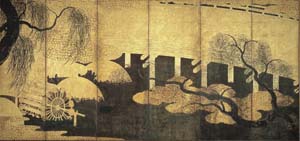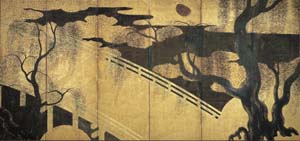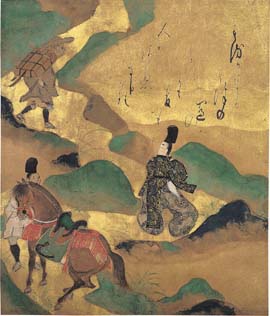

 |
 |
|
Willows, Bridge, and Waterwheel Ink, color, and silver and gold foil on paper Momoyama period, 17th century Following the example of the “One-hundred pairs of folding screens from Momoyama,” which was said to have lavishly decorated Fushimi Castle, paintings depicting the theme of willows, bridge, and waterwheel came to be widely made from the Momoyama to early Edo period. The many existing examples today attest to their popularity. The execution of this motif is generally uniform and stylistically similar. An arched bridge spans gently over an expansive river that is arranged in the center of the composition, while a waterwheel and open-latticed bamboo basket-like containers are arranged on the left, and a silver moon appears on the upper right. Riverbank willows spread across the scene from right to left, and progressively their leaves reflect the seasonal changes and the flow of time as spring turns to summer. It does not seem that Willows, Bridge, and Waterwheel paintings necessarily capture a specific place rather they exemplify an extremely ornate screen covered in gold leaf. During the prosperous Momoyama period, gold was used extensively to decorate the interiors and exteriors of the castles and used on the applied arts. In this way, gold came to be representative of its art. At times, a late Muromachi painting of the Uji River (and Uji Bridge) is seen as the source for the imagery of this motif. In this case, the gold ground is interpreted as a Buddhist metaphor for the Pure Land, connecting the Uji River and the nearby Byôdô-in Temple, which symbolizes the Pure Land, to the courtier Fujiwara Yorimichi (992-1074) and his wish to born there. Although this is merely one interpretation, the bridge in the composition of Willow, Bridge, and Waterwheel represents the symbolic one that invites the devotee across to a golden paradise and that connects this world to the Buddha’s shore. The moon symbolizes the light of the Buddha that shines in the night, and the waterwheel denotes the Buddhist concept of transmigration. There are many Buddhist and Shinto-related works in the Burke Collection, and although it is not clear when Mrs. Burke acquired this painting, she herself once said, “My husband and I had several religious works, however, after his death, such works increased.” In this way, perhaps similar sentiments as the courtier Yoshimichi may have inspired Mrs. Burke in this “Bridge of Dreams.” |
|
 “Utsu no yama”: Episode from the Ise Monogatari “Utsu no yama”: Episode from the Ise MonogatariBy Tawaraya Sôtatsu (n.d.) Ink, color, and gold on paper Edo period, 17th century Ise monogatari (Tales of Ise), which was written in the early Heian period (794-1185), lyrically recounts the romantic episodes of its protagonist Ariwara no Narihira (825-880), through a collection of poetic verses. By the tenth century, various scenes from this tale were pictorially depicted in the form of illustrated narrative handscrolls and albums. “The Picture Contest” chapter from The Tale of Genji also refers to Tales of Ise. The various vignettes allows for its many variants, which convey a sense of aristocratic lifestyle and mood, emphasize the sentiments of the characters, or express the story in a more stylized, popular form. Of all the examples of classical court literature, Tales of Ise, along with The Tale of Genji, figured most prominently in the art of later generations, whether in painting or as imagery used on decorative art objects. Themes from these tales were regularly used by the Rimpa school in expressing courtly tastes and customs. Several stylistic variations and versions without text for a series of Tales of Ise on colored, square sheets of paper are thought to been produced by the studio of Tawaraya Sôtatsu. This scene comes from chapter nine of Tales of Ise. A man and his entourage travel to the province of Suruga. At Mount Utsu, the road turns dark, narrow, and overgrown with ivy and maple. The man feels despair, when an ascetic coming from the opposite direction. He asks the monk, “What are you doing on such a road?” Recognizing him, the man entrusts a letter to the monk to be delivered to a woman in the capital. This scene, “Mount Utsu”, is thought to be a late work by Sôtatsu. This image is one of thirty-six scenes, formerly owned by Masuda Donnô. It is a particularly fine image from the set. Here the green hillocks suggest the ivy-covered path from the narrative, contrasting effectively with the three harness elements in red on the horse. Narihira, wearing a formal black court hat with dark blue hunting attire, stands out against the gold ground. The poem, associated with this scene, is written in the upper right corner: “Beside Mount Utsu in Suruga, I can see you neither waking, nor, alas, even in my dreams.” |
|
|